A new suite of research projects from New York Sea Grant includes eight teams of researchers that will explore a range of stakeholder-driven topics to benefit residents in the state’s coastal region and beyond
Contacts:
Rebecca L. Shuford, NYSG’s Director, E: Rebecca.Shuford@stonybrook.edu, P (631) 632-6905
Katherine Bunting-Howarth, NYSG’s Associate Director, E: keb264@cornell.edu, P (607) 255-2832
Lane Smith, NYSG’s Research Program Coordinator, E: Lane.Smith@stonybrook.edu, P: (631) 632-9780
Paul C. Focazio, Communications Manager, NYSG, E: paul.focazio@stonybrook.edu, P: (631) 632-6910
STONY BROOK, NY, February 1, 2022 — New York Sea Grant (NYSG) has awarded approximately $1.4 million to support eight research projects, the results of which will directly address multiple high priority community, economic, and environmental objectives.
The projects — administered by NYSG and funded through the National Oceanographic and Atmospheric Administration (NOAA), Sea Grant’s federal parent agency — represent a range of stakeholder-driven topics, across a number of New York’s coastal geographies, including the Hudson, Great Lakes, and marine districts.
“We are really excited about the eight new timely and impactful projects, selected through the 2022-23 biennial competitive research program,” said NYSG director Dr. Becky Shuford. “These projects will make valuable contributions to the now 50-year legacy of NYSG-supported, science-based knowledge of benefit to New York State’s coastal communities.”
Research includes studies to:
-
Identify heat and disease resistant strains of bay scallops;
-
Evaluate the potential of seagrasses for carbon sequestration;
-
Investigate opportunities for the aquaculture industry such as cultivation of seaweeds, cold storage of shellfish larvae, and perceptions of ecosystem benefits of oysters;
-
Document Hudson River American shad populations under changing environmental conditions;
-
Examine the impact that physical processes on Lake Ontario shorelines have on native fish egg survival;
-
Pinpoint approaches to enhance bilingual communication tools about rip currents risks
Six NYSG Scholar Fellows – graduate students who will work on these projects under the mentorship of the Principal Investigators (PIs) – will be participating in the research, gaining essential skills as they become the next generation of scientists, decision-makers, educators, and environmental stewards.
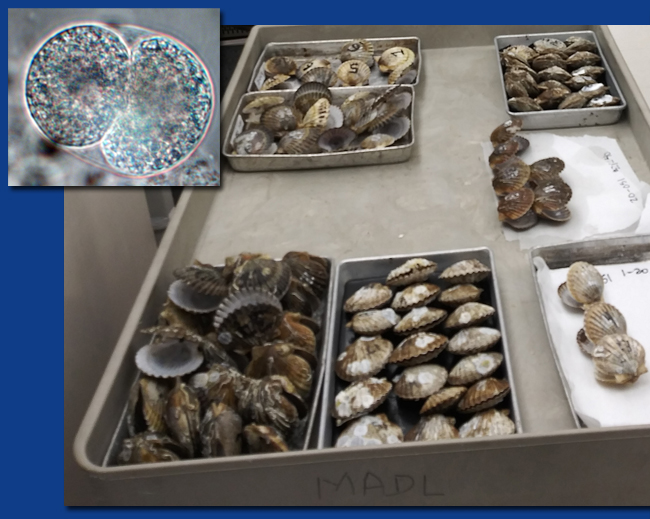
Scallop specimens await examination at SBU’s Marine Animal Disease Laboratory; (Inset) Under a microscope, two parasite cells appear like the number 8. Scientists now designate these parasites ‘bay scallop coccidia’ (BSC). You can just make out the membrane of the scallop cell surrounding the two parasite cells. Credit: Bassem Allam
Against All Odds: Development of Bay Scallop Strains That Resist Temperature and Disease Stress (Lead PI: Bassem Allam, Stony Brook University)
The bay scallop fishery on Long Island faces challenges from pathogens and climate change. This was made evident after large adult scallop die-offs in the Peconic Estuary 2019 and 2020 that hit the industry hard. This project will assess which genetic traits in naturally-occurring scallop populations provide improved survival under changing temperature and pathogen stress. The results will identify genotypes of resistant scallops that can facilitate recovery of bay scallops in New York waters and serve future development of selective breeding programs that support the bay scallop fishing industry.
“The main objective of the project is to evaluate if resistance to the parasite bay scallop coccidia and temperature stress is a heritable trait so that selective breeding strategies can be developed and implemented,” said Bassem Allam, Marinetics Endowed Professor in Marine Sciences at Stony Brook University (SBU)’s School of Marine and Atmospheric Sciences (SoMAS).
Using Coupled Hydrodynamic and Coastline Erosion Modeling to Predict the Impact of Physical Drivers Influencing Native Fish Egg Incubation Success in Lake Ontario (Lead PI: Joseph Atkinson, University at Buffalo)
Increased sedimentation in shallow lake waters is likely negatively affecting native fish egg survival in Lake Ontario by degrading spawning habitat. This project aims to characterize sedimentation processes and conditions of selected spawning areas. Results are expected to help inform effective mitigation strategies that can increase spawning success and to assist native fish restoration efforts by predicting locations of potentially successful spawning habitat.
“Our question is motivated by fish survival, longevity, and sustainability in Lake Ontario,” said Joseph Atkinson, a water resources engineer at the University at Buffalo. “As many people may know, fish are stocked every year by NYSDEC to maintain sufficient stocks to support the Lake Ontario food web. So the question is, why aren’t those stocked fish reproducing?”
Enhancing Rip Current Risk Communication in English and Spanish (Lead PI: Jase Bernhardt, Hofstra University)
Rip currents pose a hazard to visitors to Long Island’s, and the nation’s, beaches. Many groups such as the National Weather Service and local municipalities provide warnings and rip current education to the public. This project aims to improve rip current awareness and understanding, with a focus on enhanced risk communication methods and products to support the Long Island Latinx community. Partnering with local civic organizations, the project team will test existing and newly developed English and Spanish language rip current outreach tools, including a novel virtual simulation. The results of this study will provide insights which will be used to develop more effective risk communication tools that can be broadly disseminated across the country.
“Tragically each year there are one or more fatalities on Long Island beaches from rip currents and there are usually dozens across the U.S. as a whole,” said Jase Bernhardt, a professor at Hofstra University in the Department of Geology, Environment and Sustainability. “We’re now further expanding our efforts to promote rip current outreach and understanding around Long Island and specifically targeting Hispanic and Spanish-speaking communities.”
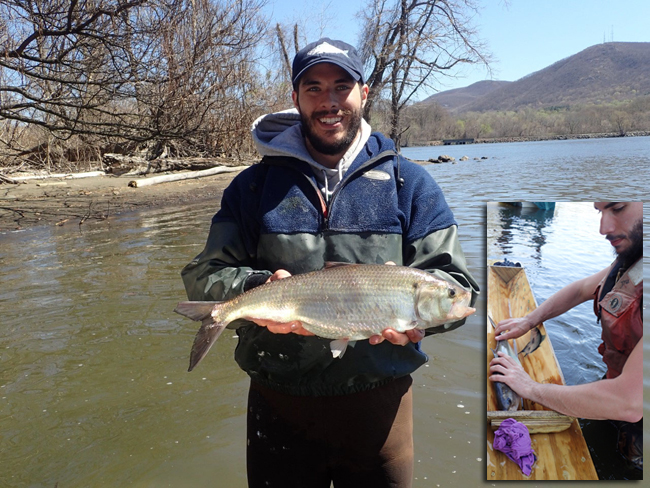
Justin Herne, a fisheries technician in the Hudson River Fisheries Unit of the NYSDEC, holds an American shad taken during annual sampling to monitor the spawning stock and recruitment of the species in the Hudson River Estuary; (Inset) After weighing and measuring the fish, Herne pauses before releasing the fish to the water. Credit: NYSDEC.
Evaluating the Changing Biogeography of American Shad In a Changing Hudson River Ecosystem (Lead PI: Yong Chen, Stony Brook University)
The American shad is an important recreational and commercial fishery species in the Hudson River that has become severely depleted. In an effort to help restore the stock, a moratorium on shad fishing was established in 2010. Despite this action, to date the Hudson River American shad stock has not rebounded. This study aims to identify factors limiting recovery. Results are expected to help inform policies and other measures to help rebuild the population and the revitalization of this important historic fishery.
“We’d like to analyze all the information available to figure out why the Hudson River American shad has not recovered after more than ten years’ moratorium on fishing,” said Yong Chen, professor of marine science at SBU.
Stakeholder Perceptions of Oyster Ecosystem Services: A Mixed Methods Approach to Mapping Services That Improve Management Efficiency (Lead PI: Joshua Drew, SUNY College of Environmental Science and Forestry)
Restoration of thriving oyster populations in New York’s Harbor and other marine waters is a common goal among various stakeholders and community members. However, there can be competing objectives for oyster restoration (e.g. improved water quality, habitat restoration, thriving populations for seafood). In this project, the research team will interview various community stakeholders to identify what they consider as most valuable about oysters and the ecosystem services they provide. Results will help identify areas of commonality and collaboration, and minimize areas of potential disagreement, for mutually beneficial management and restoration efforts.
“We’re playing to our strengths in developing a team that can look at this issue of how aquaculture facilities and oysters in general can benefit people on Long Island,” said Joshua Drew, assistant professor at SUNY College of Environmental Science and Forestry.
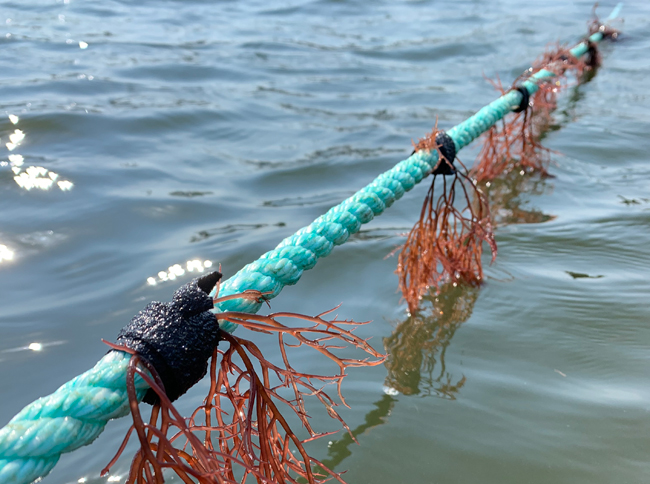
Cultivated Gracilaria hangs from a rope set up in Long Island Sound. Credit: Christopher Gobler
Diversifying New York's Marine Aquaculture Industry: Safely Integrating the Red Summer Macroalgae, Gracilaria, Into Oyster Farms and Other Systems (Lead PI: Christopher Gobler, Stony Brook University)
To help diversify and improve the resilience of New York's marine aquaculture industry, researchers are assessing the potential of a new aquaculture species that can be cultivated as a crop along-side of Eastern oyster shellfish farm operations. For this project, the research team is looking into the viability of growing Gracilaria tikvahiae as a summer seaweed crop to complement the winter seaweed crop of sugar kelp in the waters off of Long Island.
“Our project will seek to advance the aquaculture of the red seaweed, Gracilaria, in New York,” said Christopher Gobler, Endowed Chair of Coastal Ecology and Conservation at SBU’s SoMAS. “Advancing the cultivation of Gracilaria will provide environmental protection against hypoxia, harmful algal blooms, and acidification in summer and fall, as well as a year-round supply of seaweed if coupled with kelp.”
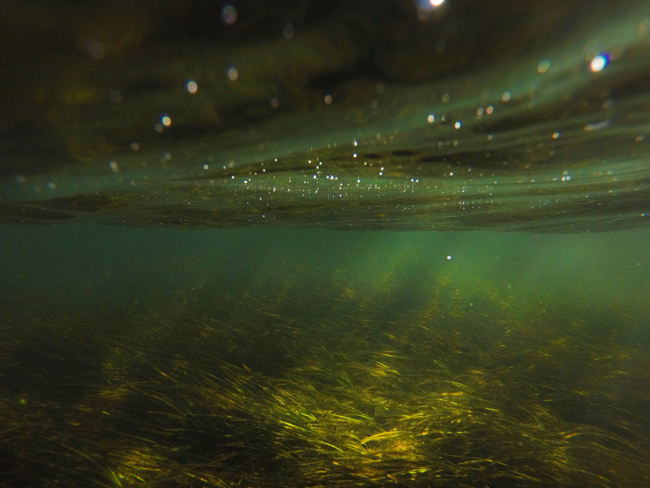
Eelgrass (Zostera marina) can be found in the Long Island South Shore Estuary. The seagrass canopy (made up of the leaves of the plants) soaks up CO2 from the water column as it photosynthesizes. Credit: Kaitlyn O’Toole
Quantifying the Carbon Sequestration Stocks, Sources and Accumulation Rates of Eelgrass (Zostera marina) In the Southshore and Peconic Estuaries Of Long Island (Lead PI: Bradley Peterson, Stony Brook University)
Increased carbon dioxide (CO2) concentrations in marine waters can lead to Ocean Acidification (OA) that can have adverse impacts on fisheries, especially shellfish. Seagrass meadows are recognized to be among the most significant blue carbon sinks, capturing CO2 out of the water column. This carbon sequestration by eelgrass (Zostera marina) could be a potential OA mitigation strategy for New York. This project is aimed at understanding the spatial variability of carbon storage in eelgrass sediments across the Long Island South Shore and Peconic Estuaries. The estimated carbon accumulation rates from the project will help assess the potential of eelgrass ecosystems to help address impacts of OA.
“Resource managers recognize the potential consequences of ocean acidification for coastal waters,” said Bradley Peterson, an associate professor at SBU’s SoMAS. “They are striving to ensure that the best available science is used to assess and respond to this emerging threat.”
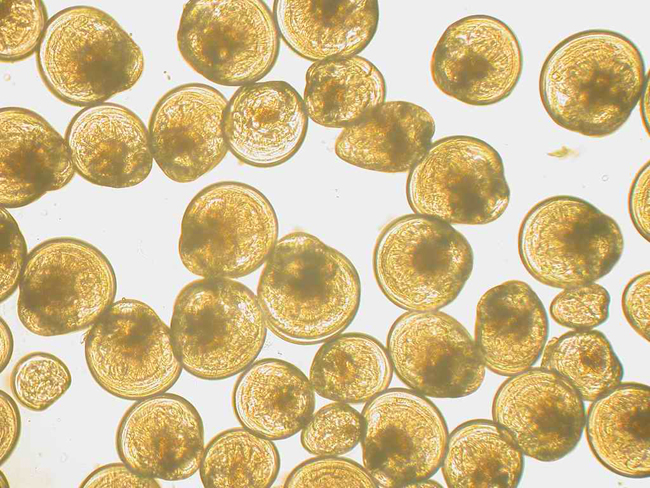
Nine day-old oyster larvae at 100x magnification. These larvae are free swimming for approximately 14 days. They form a transparent shell within 24 hours of fertilization. Credit: Gregg Rivara
Low Temperature Storage of Bivalve Larvae- A New Management Tool for Shellfish Hatcheries (Lead PI: Gregg Rivara, Cornell Cooperative Extension of Suffolk County)
Shellfish hatcheries provide an essential source of seed stock for the aquaculture industry. Spawning in hatchery operations generally results in many more larvae than can be used at one time. Finding an effective way to preserve the excess larvae (live), that currently have to be discarded, so they can be used for later seeding will enhance the potential productivity, efficiency, and economic return for the hatcheries, yielding benefit across the industry. This project will explore the use of cryoprotectants to keep larvae alive at a very low temperature, with easy-to-use methods, with the aim of extending the useful lives of hatchery larvae.
“Shellfish hatcheries spend considerable labor, energy and phytoplankton conditioning adult shellfish (broodstock) to effect out-of-season spawning,” said Gregg Rivara of Cornell Cooperative Extension, Suffolk County. “Low temperature storage of excess larvae would allow a hatchery to recoup the effort in conditioning and spawning, as well as act as an insurance plan if a meltdown in larval rearing occurred. Rather than spawn a new batch of broodstock, they could reanimate the stored larvae and raise these larvae to the nursery phase.”
More Info: New York Sea Grant
New York Sea Grant (NYSG), a cooperative program of Cornell University and the State University of New York (SUNY), is one of 34 university-based programs under the National Oceanic and Atmospheric Administration’s National Sea Grant College Program.
Since 1971, NYSG has represented a statewide network of integrated research, education and extension services promoting coastal community economic vitality, environmental sustainability and citizen awareness and understanding about the State’s marine and Great Lakes resources.
Through NYSG’s efforts, the combined talents of university scientists and extension specialists help develop and transfer science-based information to many coastal user groups—businesses and industries, federal, state and local government decision-makers and agency managers, educators, the media and the interested public.
The program maintains Great Lakes offices at Cornell University, University at Buffalo, SUNY Oswego and the Wayne County Cooperative Extension office in Newark. In the State's marine waters, NYSG has offices at Stony Brook University and Cornell Cooperative Extension of Nassau County on Long Island; at Brooklyn College, with New York City Department of Environmental Protection in Queens and at Cornell Cooperative Extension in NYC and Elmsford and Kingston in the Hudson Valley.
For updates on Sea Grant activities: www.nyseagrant.org has RSS, Facebook, Twitter, Instagram, and YouTube links. NYSG offers a free e-list sign up via www.nyseagrant.org/nycoastlines for its flagship publication, NY Coastlines/Currents, which is published quarterly.